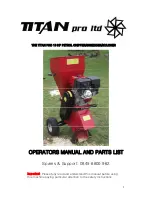
RLC-SVX19J_SHORT-GB
33
Pre-Start Checkout
WARNING!
It is imperative that L1, L2, and L3 in the
starter be connected in the A-BC phase sequence to
prevent equipment damage due to reverse rotation.
WARNING!
To prevent injury or death due to
electrocution, take extreme care when performing service
procedures with electrical power energized.
CAUTION!
Do not interchange any load leads that are
from the unit contactors or the motor terminals. Doing so
may damage the equipment.
Water System Flow Rates
Establish a balanced chilled-water fl ow through the
evaporator. The fl ow rates should be between the
minimum and maximum values given on the pressure
drop curves.
Water System Pressure Drop
Measure the water-pressure drop through the evaporator
on the fi eld installed pressure taps on the system water
piping. Use the same gauge for each measurement. Do
not include valves, strainers, or fi ttings in the pressure
drop readings.
Integrated Pump Package (Optional)
Before starting up the pump, the pipe system must be
thoroughly cleaned, fl ushed and fi lled with clean water.
Do not start the pump until it has been vented. To ensure
correct venting, open the vent screw located on the pump
housing on the suction side (see next fi gure).
The warranty does not cover any damage caused by
fl ushing the pipe system by means of the pump.
Shaft seal run-in : the seal faces are lubricated by the
pumped liquid, meaning that there may be a certain
amount of leakage from the shaft seal.
When the pump is started up for the fi rst time, or when
a new shaft seal is installed, a certain run-in period is
required before the leakage is reduced to an acceptable
level. Under normal conditions, the leaking will
evaporate. As a result no leakage will be detected.
CAUTION!
When using freeze inhibitor, never fi ll the
system with pure glycol; this will damage the shaft seal.
Always fi ll the system with diluted solution. Maximum
concentration of glycol is 45% for unit with pump
package.
If the chiller is installed in a humid environment or a
location with high air humidity, the bottom drain hole on
the pump motor should be opened. The enclosure class of
the motor is then changed from IP55 to IP44. The function
of the drain holes is to drain off water which has entered
the stator housing with air humidity.
Figure 15
–
Pump Package
A = Pump vent screw
D= Drain and fi ll valve
B = Air vent valve
E = Pump drain plug
C = Drain valve
F = Motor drain hole plug
Expansion Tank
(Pump Package Option)
The factory installed expansion tank initial pressure
should be adjusted about 0.5 bars higher than the static
pressure applied to the chiller water inlet. The static
pressure is given by the maximum water circuit height
compare to chiller location: example: the chiller is at
ground level and the circuit loop goes from basement
(at -4m compare to chiller) to third fl oor at 10 metres
above ground, the static pressure to use is 10 metres
of water (1 Bar) and the expansion tank initial pressure
should be 1.5 bars.
The expansion tank volume has been selected for
typical loop volume. The following table summarizes the
maximum volume of the chilled water loop that can be
supported by the expansion tank at different conditions.
If this maximum volume versus the required volume of
the installation is not enough, it will be necessary to add
an additional expansion tank located on the low pressure
side of the installation.
Table 3 – Maximum water loop volume in function of
static pressure of expansion tank
RTAF 090 - 250
Static pressure
1 Bar
2 Bar
3 Bar
Pure water (l)
6342
3996
1370
Ethylene glycol 20% (l)
3409
2148
736
Ethylene glycol 30% (l)
2273
1432
491
Ethylene glycol 45% (l)
1515
955
327
RTAF 280 - 550
Static pressure
1 Bar
2 Bar
3 Bar
Pure water (l)
9292
5854
2007
Ethylene glycol 20% (l)
5689
3584
1229
Ethylene glycol 30% (l)
4912
3095
1061
Ethylene glycol 45% (l)
4073
2566
880
















































